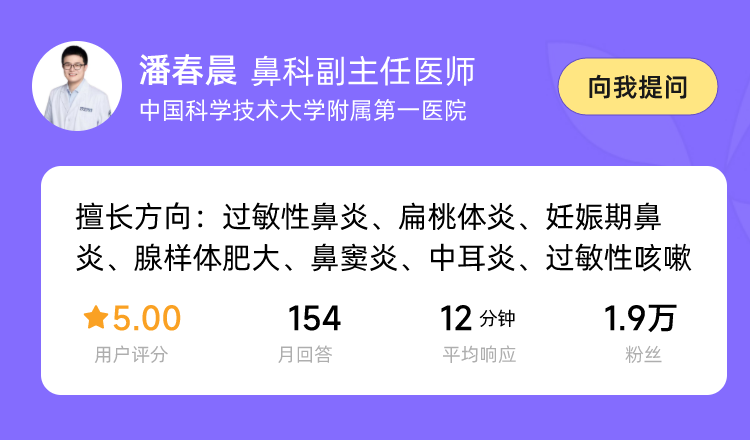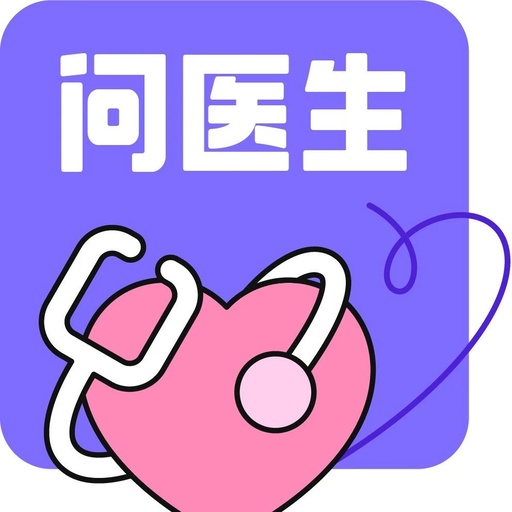
Nasal inflammation and cold symptoms are similar, often both presenting with nasal congestion and runny nose, leading many parents to be unable to distinguish between them.
Recently, a parent consulted Dr. Pan Chunchen, Deputy Chief Physician of Otolaryngology, through Dingxiang Mama. Dr. Pan provided a diagnosis based on the child’s actual condition and offered medication and lifestyle advice, which parents can apply to similar situations.
Let’s see what Dr. Pan has to say.


Symptoms and Duration of Illness: The child had a cold after the pandemic, and since then, he has felt that his nose has been blocked for a month without complete recovery. The congestion is especially severe at night, sometimes leading to mouth breathing. A few days ago, there was a thick yellow nasal discharge during the day, but recently there has been little nasal discharge, although the nose remains blocked.
Medical Consultation and Medication History: During the cold, the child took cold medicine, and after the cold, fearing allergic rhinitis, he took cetirizine hydrochloride drops twice. He felt a little better on the first day, but the improvement was not very significant.
Questions to be Answered: The parent is unsure whether it is a cold, an allergy, or nasal inflammation and seeks the doctor’s help.
* For privacy protection, patient-provided photos are not displayed here.

Hello!
The child’s medical history is clear; after the cold, he has felt that his nose has been blocked for a month without complete recovery. The congestion is especially severe at night, sometimes leading to mouth breathing. A few days ago, there was a thick yellow nasal discharge during the day.
This means that the child has had intermittent nasal congestion and yellow nasal discharge for about 30 days, with intermittent use of cold medicine and cetirizine leading to symptom relief.
1. Symptom Diagnosis
The child’s overall condition is consistent with acute bacterial sinusitis. Pediatric bacterial sinusitis often follows a viral upper respiratory infection and must be differentiated from viral upper respiratory infections.
In the early stages of a cold, there may be fever and noticeable sneezing, but usually, there is significant relief after the first 1-2 days; nasal congestion and runny nose symptoms are also prominent, and some children may have a cough.
However, these symptoms usually improve significantly within 5-7 days and disappear within 7-10 days, sometimes lasting for 2 weeks, but there will definitely be a significant trend of relief in the later stages of the illness, as it is self-limiting.
To determine whether bacterial sinusitis has occurred, the duration of the illness and the persistence of symptoms are equally important considerations:
1. Nasal symptoms (nasal congestion, runny nose, or cough due to post-nasal drip) persist for more than 10 days without signs of relief;
2. Symptoms such as runny nose and cough worsen again during the relief process;
3. High fever (temperature ≥ 39°C) with purulent nasal discharge lasting for ≥ 3 days.
If any of the above occurs, the duration and symptoms exceed those of a common cold, and bacterial sinusitis can be considered.
Pediatric bacterial sinusitis primarily presents with persistent nasal congestion and increased nasal secretions, as well as throat clearing, a sensation of liquid swallowing, and more pronounced cough upon waking or lying down.
Based on the child’s medical history, it is preliminarily judged that the child fits the first scenario of acute bacterial sinusitis.
2. Recommended Treatment Plan for the Child
1. For acute bacterial sinusitis, the main treatment is oral antibiotics, with amoxicillin-clavulanate as the first choice.
Since there has been a long interval since the last medication and the risk of antibiotic resistance is low, the treatment will start with amoxicillin-clavulanate at a 7:1 ratio, 0.2285 g specification. The general recommended daily dosage is 45 mg per kg of body weight (based on amoxicillin, with a total daily dose not exceeding 1750 mg). For example, if the child weighs 22 kg, the daily dosage would be 45 * 22 = 990 mg, divided into two doses, so each dose would be 445 mg (amoxicillin). Each 0.2285 g packet contains 200 mg of amoxicillin, so the child should take 2.5 packets each time.
Antibiotic efficacy should be evaluated after three days of use. Generally, if the antibiotic treatment is effective, after 72 hours, the child’s nasal congestion, phlegm, and yellow nasal discharge symptoms will show significant improvement. If there is no relief after 3-5 days of treatment, the medication should be stopped and switched to amoxicillin-clavulanate at a 14:1 ratio, at 90 mg/(kg•d) (based on the amoxicillin component), taken in two doses. Continue this until completing a 10-14 day course. The principle of antibiotic use is to ensure adequate dosage and duration. If the dosage is insufficient or the duration is too short, it may lead to bacterial resistance and recurrent symptoms.
2. Nasal Spray:According to treatment guidelines, children with sinusitis also need to use a corticosteroid nasal spray. Mometasone furoate nasal spray can be selected. Each morning, after cleaning the nose, have the child blow their nose or use a nasal aspirator to help clear the nasal discharge, then use the nasal spray, one spray in each nostril, and stop using it after 1-2 weeks when the child has no symptoms.
Cetirizine can be stopped since the child does not have symptoms of nasal itching, sneezing, or rubbing the nose, indicating no allergy. Cold medicine is ineffective for sinusitis and should be discontinued.
3. Additional Considerations:
1. As the child does not have symptoms of nasal itching, sneezing, or rubbing the nose, indicating no allergy, cetirizine can be stopped. Cold medicine is ineffective for sinusitis and should be discontinued. Nasal irrigation can help expel nasal secretions and improve nasal congestion and runny nose symptoms.
2. Keep indoor air humid; a humidifier can be used.
3. Avoid exposure to secondhand smoke, dust, cooking fumes, and other irritating gases.
Wishing you good health!
* Note: The medication guidance in this article is specific to this consultation case; please consult a doctor for prescription medication use.

Thank you, doctor. Additionally, the child has been experiencing frequent nosebleeds lately; could this also be related?

* Click the voice playback button below to listen to the doctor’s response:
Reminder: The above is an online consultation case; treatment suggestions may not apply to your child’s situation.
However, one thing is certain: as long as you seek a doctor’s assessment and standardized treatment promptly, it can effectively improve the situation. A doctor can help evaluate the child’s specific condition and provide more targeted improvement plan suggestions. With the recent changeable weather, the child’s immunity is weak, and nasal inflammation issues are prone to recurrence, making frequent hospital visits inconvenient.
Child’s Nasal Congestion and Runny Nose
Consult a Top-Tier Doctor
👇
* Online consultations should provide clear diagnostic case materials, such as outpatient medical records, diagnostic certificates, etc., to help doctors make more accurate judgments about the condition.
After asking, click here to quickly view the doctor’s response
Common Q&A for Consultations
❶ Consultation Entry: Download the Dingxiang Mama App or search for the Dingxiang Doctor mini-program, then click “Ask a Doctor” on the homepage to consult a doctor online.
❷ Number of Consultations: One consultation includes 3 opportunities for questions (one question with two follow-ups), with multiple questions allowed (up to 500 words), supporting video and image uploads (check reports, medication images, etc. can be photographed and uploaded), valid for 24 hours.
❸ View Responses: If there are ongoing consultations, you can enter the Dingxiang Mama App or mini-program, click “My” at the bottom – “My Consultations” to receive the doctor’s response promptly.
❹ Customer Service: For more questions, enter the Dingxiang Mama App or mini-program, click “My” at the bottom – “Online Customer Service” for detailed inquiries.
Planning and Production
Supervisor: Wen Sheng
Layout: Jing Jing

